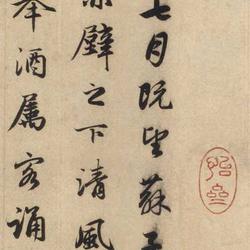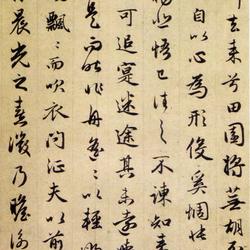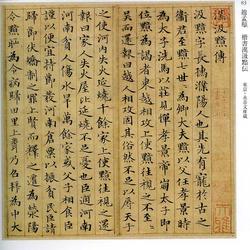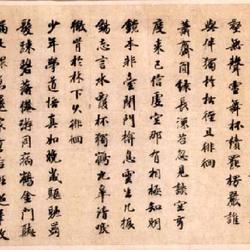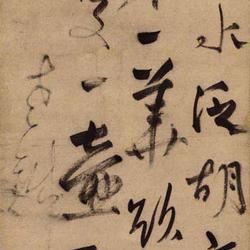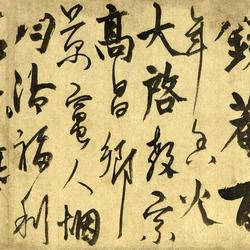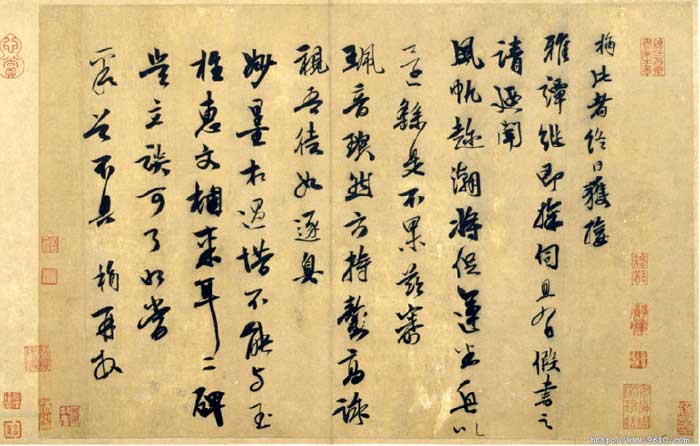
Yuan Jue's "Ya Tan Tie", running script, paper. 28.3 x 38.9 cm. Collection of the Palace Museum, Beijing.
Explanation:
Juebi was picked up by Yatan all day long, and then he went to visit him, and asked for a fake letter. I heard that the sails took advantage of the tide to help the rice boat return, but it was to no avail. The sound of the pendant is resonant, and Fang holds his chela and sings it high, looking at my disciples as if they are chasing a stink. Miao Mo met, but it was a pity that he could not be reunited with Yu Gui Huiwen. How can we talk about the two monuments before they are erected? We should gather together tomorrow. Does not have. Goodbye, Jue.
This painting has 12 appreciation seals including "Collection of Anyi Zhou Family", "Appreciation of Lotus Woodcutter", "Jingxian", "Seal of Tan's District Zhai Calligraphy and Painting", "Zhao Shuyan", and 2 half seals.
This post is a social letter, so it is written with a free hand, the composition is natural and appropriate, the writing is well-organized, the handwriting and turning are deliberately delicate, and it has Mi Fu's calm and joyful writing style, with a strange and dangerous style.
It is recorded in two books: "Mo Yuan Hui Guan Fa Shu Juan" and "San Yu Tang Calligraphy and Painting Catalog".
The above information comes from the website of the Palace Museum
Appendix: Shi Gu Tu Xin Hua Yuan Jue
——Interpretation of "Yatan Tie" ■Liu Dongqin
Reprinted from "Calligraphy News" Issue 3, 2008, January 16, 2008 (Total Issue 1,200)
Yuan Jue (1266~1327), whose courtesy name was Bo Chang, also known as Qingrong Jushi, and Jianyi Jushi, was from Yinxian County. His posthumous title was Wenqing. In the early years of Dade in the Yuan Dynasty (1297), he was recommended as an examiner of the Hanlin Academy of National History, a direct bachelor of the Hanlin Academy, and a fellow student of Zhizhigao in national history. Later, he became a bachelor. It was ordered to compile the grand ceremonies of the three dynasties of Chengzong, Wuzong and Renzong. Yuan Yingzong appreciated Yuan Jue's erudition very much and ordered him to write the history of Song, Liao and Jin. This was later interrupted due to changes in the court. Yuan Jue first studied under Dai Biao Yuan, and later studied under Wang Yinglin of Yin County, whereupon he became famous as Neng Wen. In the early years of Taiding (1324), Yuan Jue resigned from office and returned to his hometown. He wrote "Records of the Five Dynasties", "Records of Renzong", "Reading Records", "Biography of Eminent Monks of Siming", "Zhi of Yanyou Siming", "Records of Siming" "Poems of Eminent Monks" etc. He likes to accumulate classics and inherits the legacy of his great ancestor Yuan Shao. He collects thousands of books and has a rich collection of books in eastern Zhejiang. After his death, his family kept it improperly and destroyed more than half of it.
Zhao Mengfu held high the banner of restorationism in the Yuan Dynasty. Zhao's calligraphy style became very popular in the Yuan Dynasty, and his followers became popular. Yuan Jue is Zhao Mengfu's cousin, so he naturally has the opportunity to see Zhao Mengfu writing in person. Zhao Mengfu's calligraphy thoughts and aesthetic taste will undoubtedly have an impact on him. From Yuan Jue's works, he can clearly feel a strong Jin Dynasty. Tang breath. Analyzing Yuan Jue's works, we will find that they are also based on the calligraphy styles of Jin and Tang Dynasties. Yuan Jue's works clearly show a different flavor from those of contemporary calligraphers, especially Zhao Mengfu. Tao Zongyi's "History of Calligraphy" says: "Yuan Jue's calligraphy came from the Jin and Tang Dynasties and became a family of his own." Li Rihua said: "Yuan Qingrong's calligraphy is fast, sharp and calm, and he is sincere to his descendants." It means that Yuan Jue's calligraphy was greatly influenced by Liu Gongquan.
Yuan Jue's "Yatan Tie" is not only based on the Jin and Tang Dynasties, but also nourished by Mi Fu's calligraphy. In the calligraphy world of the Yuan Dynasty, where Zhao Mengfu's calligraphy style was shrouded, there were few calligraphers who directly imitated the Song Dynasty and studied Mi Fu with such authentic skills. Yuan Jue can be said to be the best among them. Yuan Jue showed his unique insights and affirmation of Mi Fu's calligraphy in many inscriptions and postscripts. For example, "Postscript of Mi Yuan Zhang Shu" says: "Yuan Zhang studied Xiao Cheng's calligraphy in his prime, later studied Duan Jizhan, and finally studied Chu's calligraphy." Henan, its style changed three times, and it was later restored to large-scale orders, and running script was often longer." He also said: "The change in cursive script began with Zhang Xu, and the change in running script started with Mi Lao." Especially for Mi Fulin's profound ancient skills, Yuan Jie is sincerely convinced. "Ya Tan Tie" is mainly written in running script, with a few cursive calligraphy. The words "Yun, Shen, Neng, Lai" in the post clearly have the shadow of Mi Fu. Purpose. The brush is used in all directions, the line quality is extremely high, and some delicate strokes also show perfect texture. The glyph structure is like an oblique reverse, randomly scattered, with both the side of the rice character and the elegance of the king character. The whole article is full of energy, spirit, insight and vitality, showing profound ancient learning skills and extraordinary skills. Through "Ya Tan Tie", we can learn a rigorous and serious attitude. If you want to surpass the ancients in studying calligraphy, you must first get infinitely close to the ancients. Yuan Jue was an important connoisseur in the Yuan Dynasty. He appraised and inscribed many famous works in the Jin, Tang, Song, and Yuan dynasties. Among them, Zhao Mengfu's paintings were the most numerous. These insights are the intuitive feelings of his artistic aesthetics, and they are very beneficial to read. .

